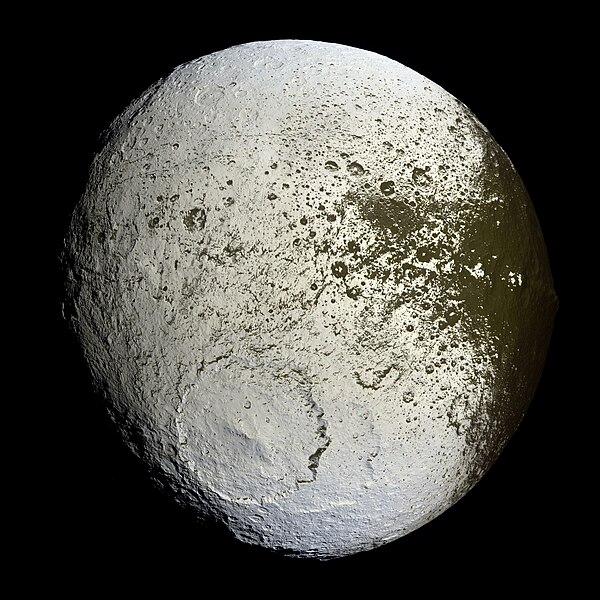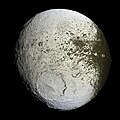പ്രമാണം:Iapetus as seen by the Cassini probe - 20071008.jpg

ഈ പ്രിവ്യൂവിന്റെ വലിപ്പം: 600 × 600 പിക്സലുകൾ. മറ്റ് റെസലൂഷനുകൾ: 240 × 240 പിക്സലുകൾ | 480 × 480 പിക്സലുകൾ | 768 × 768 പിക്സലുകൾ | 1,024 × 1,024 പിക്സലുകൾ | 2,048 × 2,048 പിക്സലുകൾ | 4,032 × 4,032 പിക്സലുകൾ.
പൂർണ്ണ വലിപ്പം (4,032 × 4,032 പിക്സൽ, പ്രമാണത്തിന്റെ വലിപ്പം: 6.22 എം.ബി., മൈം തരം: image/jpeg)
പ്രമാണ നാൾവഴി
ഏതെങ്കിലും തീയതി/സമയ കണ്ണിയിൽ ഞെക്കിയാൽ പ്രസ്തുതസമയത്ത് ഈ പ്രമാണം എങ്ങനെയായിരുന്നു എന്നു കാണാം.
| തീയതി/സമയം | ലഘുചിത്രം | അളവുകൾ | ഉപയോക്താവ് | അഭിപ്രായം | |
|---|---|---|---|---|---|
| നിലവിലുള്ളത് | 18:07, 12 ഡിസംബർ 2018 |  | 4,032 × 4,032 (6.22 എം.ബി.) | Kesäperuna | 100% JPEG quality from full quality TIFF, slightly cropped to be more centered. |
| 09:18, 9 ഒക്ടോബർ 2007 |  | 4,100 × 4,100 (1.56 എം.ബി.) | Startaq | {{Information |Description = Cassini captures the first high-resolution glimpse of the bright trailing hemisphere of Saturn's moon Iapetus. This false-color mosaic shows the entire hemisphere of Iapetus (1,468 kilometers, or 912 miles across) visible fro |
പ്രമാണത്തിന്റെ ഉപയോഗം
താഴെ കാണുന്ന 2 താളുകളിൽ ഈ ചിത്രം ഉപയോഗിക്കുന്നു:
പ്രമാണത്തിന്റെ ആഗോള ഉപയോഗം
താഴെ കൊടുത്തിരിക്കുന്ന മറ്റ് വിക്കികൾ ഈ പ്രമാണം ഉപയോഗിക്കുന്നു:
- af.wikipedia.org സംരംഭത്തിലെ ഉപയോഗം
- an.wikipedia.org സംരംഭത്തിലെ ഉപയോഗം
- ar.wikipedia.org സംരംഭത്തിലെ ഉപയോഗം
- ary.wikipedia.org സംരംഭത്തിലെ ഉപയോഗം
- arz.wikipedia.org സംരംഭത്തിലെ ഉപയോഗം
- ast.wikipedia.org സംരംഭത്തിലെ ഉപയോഗം
- az.wikipedia.org സംരംഭത്തിലെ ഉപയോഗം
- ba.wikipedia.org സംരംഭത്തിലെ ഉപയോഗം
- be.wikipedia.org സംരംഭത്തിലെ ഉപയോഗം
- bg.wikipedia.org സംരംഭത്തിലെ ഉപയോഗം
- bn.wikipedia.org സംരംഭത്തിലെ ഉപയോഗം
- bn.wikibooks.org സംരംഭത്തിലെ ഉപയോഗം
- bs.wikipedia.org സംരംഭത്തിലെ ഉപയോഗം
- ca.wikipedia.org സംരംഭത്തിലെ ഉപയോഗം
- ckb.wikipedia.org സംരംഭത്തിലെ ഉപയോഗം
- cs.wikipedia.org സംരംഭത്തിലെ ഉപയോഗം
- cv.wikipedia.org സംരംഭത്തിലെ ഉപയോഗം
- cy.wikipedia.org സംരംഭത്തിലെ ഉപയോഗം
- de.wikipedia.org സംരംഭത്തിലെ ഉപയോഗം
ഈ പ്രമാണത്തിന്റെ കൂടുതൽ ആഗോള ഉപയോഗം കാണുക.



